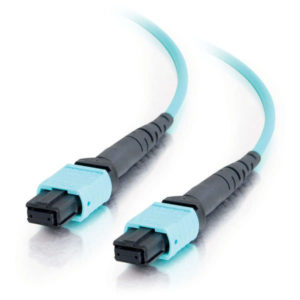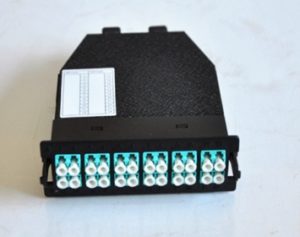The number of network connections in data centers is rising rapidly. Traditional fiber cables can make the data center crammed and difficult to manage. To solve this problem, data centers have to achieve ultra-high density in cabling to accommodate all of the cabling required. The MTP/MPO cables, which bring together 8, 12 or 24 fibers in a single interface have been proven to be a practical solution. Incorporating to meet the 40GBASE-SR4 and 100GBASE-SR10 standard.
MTP/MPO connector factory terminated assembly can house 6 to 72 fibers, with 12-fiber and 24-fiber arrays being the most common. MTP/MPO connector is available in a male version (with pins) or a female version (without pins).The quantity of data transmitted worldwide is growing exponentially and the need for ever-greater bandwidths is unrelenting. Though the current data volumes demanded in backbone cabling can still be handled with 10 G, the forecast trends will require the introduction of the next technologies, 40 and 100 G. As a result, data centers must respond to provide sufficient capacities and plan for upcoming requirements. To meet this demand, 40G QSFP+ transceivers, MTP/MPO cables and other related products are now in the market. MTP/MPO cables in the data centers play an important role in ultra-high density cabling.
Details of MTP/MPO Cables
MTP/MPO cables are composed of MTP/MPO connectors and fiber optic cables, other connectors such as LC may also be found in some kinds of MTP/MPO cables. The fiber cables used are generally OM3 and OM4, which are laser optimized multi-mode optical fibers. It is important to have an overall understanding of MTP/MPO connectors (known as multi-fiber push-on and also as multi-path push-on).
MPO connectors are available in a female version (without pins), or a male version (with pins) as shown in the following picture. The pins ensure the exact alignment of the fronts of the connectors, and also they ensure the end faces of the fibers are not off set. Noses and guide grooves (key) on the top side are the two other clearly visible features, which ensure the adapter hold the connector with the correct ends aligned with each other. Based on the placement of the key, two types of MPO adapters are available. One is “key-up to key-down”. It means the key is up on one side and down on the other. The two connectors are connected turned 180° in relation to each other. The other one is “key-up to key-up”. It means both keys are up. The two connectors are connected while in the same position in relation to each other.
connectors, and also they ensure the end faces of the fibers are not off set. Noses and guide grooves (key) on the top side are the two other clearly visible features, which ensure the adapter hold the connector with the correct ends aligned with each other. Based on the placement of the key, two types of MPO adapters are available. One is “key-up to key-down”. It means the key is up on one side and down on the other. The two connectors are connected turned 180° in relation to each other. The other one is “key-up to key-up”. It means both keys are up. The two connectors are connected while in the same position in relation to each other.
MPO related products
MTP/MPO Trunk Cable
MTP/MPO trunk cable works to connect modules together as a permanent link. The trunk cables are available with 12, 24, 48 and 72 fibers. They are often used to interconnect cassettes, panels or ruggedized MPO fan-outs, and to facilitate rapid deployment of high-density backbone cabling in data centers and other high fiber environments. MTP/MPO trunk  cable requires greater care in planning but has a number of advantages, such as higher quality, minimal skew, shorter installation time, better protection, smaller volume of cable and lower total costs. The MTP/MPO trunk cables are constructed from loose tube, gel-filled indoor/outdoor rated cables and are used for interconnect spanning MDA, HAD and EDA zones.
cable requires greater care in planning but has a number of advantages, such as higher quality, minimal skew, shorter installation time, better protection, smaller volume of cable and lower total costs. The MTP/MPO trunk cables are constructed from loose tube, gel-filled indoor/outdoor rated cables and are used for interconnect spanning MDA, HAD and EDA zones.
MTP/ MPO Harness Cable
MTP/MPO harness cable, known as MTP/MPO breakout cable or MTP/MPO fan-out cable,  offers a transition from multi-fiber cables to individual fibers or duplex connectors. MTP/MPO harness cable has a single MTP connector on one end that breaks out into 6 or 12 connectors, and these connector types can be LC, SC, ST, etc. MTP/MPO harness is available in 4, 6, 8, or 12 fiber ribbon configurations with lengths about 10, 20, 30 meters and other customized lengths. Harness cable provides a reliable, cost-effective cabling option for 10G-40G.
offers a transition from multi-fiber cables to individual fibers or duplex connectors. MTP/MPO harness cable has a single MTP connector on one end that breaks out into 6 or 12 connectors, and these connector types can be LC, SC, ST, etc. MTP/MPO harness is available in 4, 6, 8, or 12 fiber ribbon configurations with lengths about 10, 20, 30 meters and other customized lengths. Harness cable provides a reliable, cost-effective cabling option for 10G-40G.
MTP-LC Breakout Patch Panel
Data traffic keeps accelerating and legacy 10/25G systems are hardly enough for it, making migration to higher-speed 40/100G imperative. The 96-fiber MTP-LC breakout patch panel can assist in making the transition: use MTP cables to connect your 40/100Gb switches to the rear ports of the panel, then add duplex LC cables to connect your 10 Gb devices to the breakout panel’s front ports. This MTP-LC breakout patch panel is designed with a removable cable  management plate at the back, it effectively simplifies trunk cable organization, facilitates installation and reduces cable clutter.
management plate at the back, it effectively simplifies trunk cable organization, facilitates installation and reduces cable clutter.
Speed is paramount to a data center, therefore data center are always on the road to higher density data rates. MTP/MPO fiber optic cable assembly appears to be the best option to improve speed, agility and performance of the system. Considering the time saving, space efficiency and flexibility, it is worthwhile to make MTP/MPO cabling a part of your data center.
